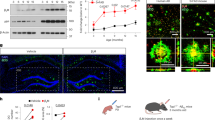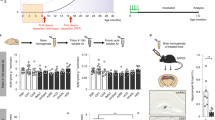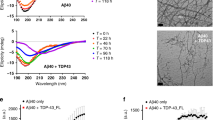Abstract
We have shown that interaction of CD40 with CD40L enables microglial activation in response to amyloid-β peptide (Aβ), which is associated with Alzheimer's disease (AD)-like neuronal tau hyperphosphorylation in vivo. Here we report that transgenic mice overproducing Aβ, but deficient in CD40L, showed decreased astrocytosis and microgliosis associated with diminished Aβ levels and β-amyloid plaque load. Furthermore, in the PSAPP transgenic mouse model of AD, a depleting antibody against CD40L caused marked attenuation of Aβ/β-amyloid pathology, which was associated with decreased amyloidogenic processing of amyloid precursor protein (APP) and increased circulating levels of Aβ. Conversely, in neuroblastoma cells overexpressing wild-type human APP, the CD40–CD40L interaction resulted in amyloidogenic APP processing. These findings suggest several possible mechanisms underlying mitigation of AD pathology in response to CD40L depletion, and validate the CD40–CD40L interaction as a target for therapeutic intervention in AD.
This is a preview of subscription content, access via your institution
Access options
Subscribe to this journal
Receive 12 print issues and online access
$209.00 per year
only $17.42 per issue
Buy this article
- Purchase on SpringerLink
- Instant access to full article PDF
Prices may be subject to local taxes which are calculated during checkout




Similar content being viewed by others
References
Selkoe, D.J. Alzheimer's disease: genes, proteins and therapy. Physiol. Rev. 81, 741–766 (2001).
McGeer, E.G. & McGeer, P.L. The importance of inflammatory mechanisms in Alzheimer disease. Exp. Gerontol. 33, 371–378 (1998).
Rogers, J. et al. Inflammation and Alzheimer's disease pathogenesis. Neurobiol. Aging 17, 681–686 (1996).
Itagaki, S., McGeer, P.L., Akiyama, H., Zhu, S. & Selkoe, D. Relationship of microglia and astrocytes to amyloid deposits of Alzheimer disease. J. Neuroimmunol. 24, 173–182 (1989).
Giulian, D. Microglia and the immune pathology of Alzheimer disease. Am. J. Hum. Genet. 65, 13–18 (1999).
Barger, S.W. & Harmon, A.D. Microglial activation by Alzheimer amyloid precursor protein and modulation by apolipoprotein E. Nature 388, 878–881 (1997).
Meda, L. et al. Activation of microglial cells by beta-amyloid protein and interferon-gamma. Nature 374, 647–650 (1995).
Grewal, I.S. & Flavell, R.A. CD40 and CD154 in cell-mediated immunity. Annu. Rev. Immunol. 16, 111–135 (1998).
Nguyen, V.T, Walker, W.S. & Benveniste, E.N. Post-transcriptional inhibition of CD40 gene expression in microglia by transforming growth factor-beta. Eur. J. Immunol. 28, 2537–2548 (1998).
Tan, J. et al. Microglial activation resulting from CD40–CD40L interaction after beta-amyloid stimulation. Science 286, 2352–2355 (1999).
Calingasan, N.Y., Erdely, H.A. & Altar, C.A. Identification of CD40 ligand in Alzheimer's disease and in animal models of Alzheimer's disease and brain injury. Neurobiol. Aging 23, 31–39 (2002).
Togo, T. et al. Expression of CD40 in the brain of Alzheimer's disease and other neurological diseases. Brain Res. 885, 117–121 (2000).
Hsiao, K. et al. Correlative memory deficits, Abeta elevation, and amyloid plaques in transgenic mice. Science 274, 99–102 (1996).
Irizarry, M.C., McNamara, M., Fedorchak, K., Hsiao, K. & Hyman, B.T. APPSw transgenic mice develop age-related A beta deposits and neuropil abnormalities, but noneuronal loss in CA1. Neuropathol. Exp. Neurol. 56, 965–973 (1997).
Holcomb, L. et al. Accelerated Alzheimer-type phenotype in transgenic mice carrying both mutant amyloid precursor protein and presenilin 1 transgenes. Nat. Med. 4, 97–100 (1998).
Schonbeck, U., Sukhova, G.K., Shimizu, K., Mach, F. & Libby, P. Inhibition of CD40 signaling limits evolution of established atherosclerosis in mice. Proc. Natl. Acad. Sci. U S A 97, 7458–7463 (2000).
Schmidt, M.L., Lee, V.M. & Trojanowski, J.Q. Relative abundance of tau and neurofilament epitopes in hippocampal neurofibrillary tangles. Am. J. Pathol. 136, 1069–1075 (1990).
Ball, M.J. et al. A new definition of Alzheimer's disease: a hippocampal dementia. Lancet 1, 14–16 (1985).
Luo, Y. et al. Mice deficient in BACE1, the Alzheimer's beta-secretase, have normal phenotype and abolished beta-amyloid generation. Nat. Neurosci. 4, 231–232 (2001).
Tan, J. et al. CD40 is expressed and functional on neuronal cells. EMBO J. 21, 643–652 (2002).
Thinakaran, G., Teplow, D.B., Siman, R., Greenberg, B. & Sisodia, S.S. Metabolism of the “Swedish” amyloid precursor protein variant in neuro2a (N2a) cells. Evidence that cleavage at the “beta-secretase” site occurs in the golgi apparatus. J. Biol. Chem. 271, 9390–9397 (1996).
Schonbeck, U. et al. Ligation of CD40 activates interleukin-1beta-converting enzyme (caspase-1) activity in vascular smooth muscle and endothelial cells and promotes elaboration of active interleukin 1beta. J. Biol. Chem. 272, 19569–19574 (1997).
Mach, F. et al. Functional CD40 ligand is expressed on human vascular endothelial cells, smooth muscle cells, and macrophages: implications for CD40–CD40 ligand signaling in atherosclerosis. Proc. Natl. Acad. Sci. U S A 94, 1931–1936 (1997).
Piguet, P.F. et al. Role of CD40–CD40L in mouse severe malaria. Am. J. Pathol. 159, 733–742 (2001).
DeMattos, R.B. et al. Peripheral anti-A beta antibody alters CNS and plasma A beta clearance and decreases brain A beta burden in a mouse model of Alzheimer's disease. Proc. Natl. Acad. Sci. U S A 98, 8850–8855 (2001).
DeMattos, R.B., Bales, K.R., Cummins, D.J., Paul, S.M. & Holtzman, D.M. Brain to plasma amyloid-beta efflux: a measure of brain amyloid burden in a mouse model of Alzheimer's disease. Science 295, 2264–2267 (2002).
Schenk D. et al. Immunization with amyloid-beta attenuates Alzheimer-disease-like pathology in the PDAPP mouse. Nature 400, 173–177 (1999).
Wilcock, D.M. et al. Number of Abeta inoculations in APP+PS1 transgenic mice influences antibody titers, microglial activation, and congophilic plaque levels. DNA Cell Biol. 20, 731–736 (2001).
DiCarlo G. et al. Intrahippocampal LPS injections reduce Abeta load in APP+PS1 transgenic mice. Neurobiol. Aging 22, 1007–1012 (2001).
Qiao, X., Cummins, D.J. & Paul, S.M. Neuroinflammation-induced acceleration of amyloid deposition in the APPV717F transgenic mouse. Eur. J. Neurosci. 14, 474–482 (2001).
Lim, G.P. et al. Ibuprofen suppresses plaque pathology and inflammation in a mouse model for Alzheimer's disease. J. Neurosci. 20, 5709–5714 (2000).
Lim, G.P. et al. The curry spice curcumin reduces oxidative damage and amyloid pathology in an Alzheimer transgenic mouse. J. Neurosci. 21, 8370–8377 (2001).
Jantzen, P.T. et al. Microglial activation and beta-amyloid deposit reduction caused by a nitric oxide-releasing nonsteroidal anti-inflammatory drug in amyloid precursor protein plus presenilin-1 transgenic mice. J. Neurosci. 22, 2246–2256 (2002).
Xu, J. et al. Mice deficient for the CD40 ligand. Immunity 1, 423–431 (1994).
Johnson-Wood, K. et al. Amyloid precursor protein processing and A beta42 deposition in a transgenic mouse model of Alzheimer disease. Proc. Natl. Acad. Sci. USA 94, 1550–1555 (1997).
Acknowledgements
We are grateful to D. Roskamp and R. Roskamp for support, which made this work possible. This work was supported in part by the Alzheimer's Association. We thank Y. Wu and J. Zeng for assistance in preparating mouse brain homogenates and for western analysis. We also thank S. Gandy (New York University, Nathan S. Kline Institute for Psychiatric Research) and H. Steiner (Adolf Butenandt-Institute, Ludwig-Maximilians-University) for providing antibodies against the C-terminus of APP and G. Thinakaran (University of Chicago, Committee on Neurobiology) and S. Gandy for providing the N2a cell line that stably overexpresses wild-type human APP-695.
Author information
Authors and Affiliations
Corresponding author
Ethics declarations
Competing interests
The authors declare no competing financial interests.
Rights and permissions
About this article
Cite this article
Tan, J., Town, T., Crawford, F. et al. Role of CD40 ligand in amyloidosis in transgenic Alzheimer's mice. Nat Neurosci 5, 1288–1293 (2002). https://doi.org/10.1038/nn968
Received:
Accepted:
Published:
Issue Date:
DOI: https://doi.org/10.1038/nn968



